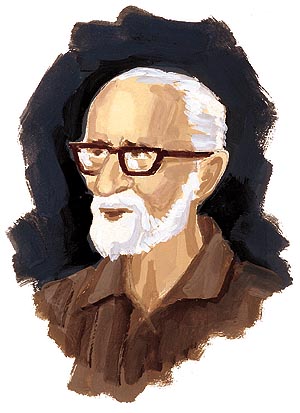ON his way to Lake Manasarovar in 1945, Dr. Salim Ali stopped his vehicle, got off it, took out his binoculars and started looking for rare birds of the region. His sharp eyes spotted a bird and he began to pan his field glasses along with it. At times the bird got out of his view, and Dr. Salim Ali had to take a couple of steps back in order to track the bird's flight. This went on for quite some time. Just then the bird watcher heard the sound of falling rocks. His concentration broken, he turned back and saw the boulders fall into the Kali river, many hundred feet below. Had he watched his bird for some more time, he, too, would have gone along with the boulders into the river! Such was the devotion of Dr. Salim Ali to birds that he forgot everything else in life.
 In retrospect, it now seems ironical indeed that, Dr Salim Ali, the man who fought all his life for preservation of birds, actually fell in love with birds only after shooting a house sparrow at the age of ten. Picking up the dead bird, he noticed a yellow patch on its neck. Intrigued by it he took the dead bird to his uncle for an answer. Since his uncle was no expert ornithologist, he guided young Salim to W. S. Millard, honourary Secretary of the Bombay Natural History Society. Millard not only answered the inquisitive boy's questions, but also taught him to love birds instead of shooting them. The advice was well taken, and the boy grew up to be a 'moving encyclopaedia of birds'.
In retrospect, it now seems ironical indeed that, Dr Salim Ali, the man who fought all his life for preservation of birds, actually fell in love with birds only after shooting a house sparrow at the age of ten. Picking up the dead bird, he noticed a yellow patch on its neck. Intrigued by it he took the dead bird to his uncle for an answer. Since his uncle was no expert ornithologist, he guided young Salim to W. S. Millard, honourary Secretary of the Bombay Natural History Society. Millard not only answered the inquisitive boy's questions, but also taught him to love birds instead of shooting them. The advice was well taken, and the boy grew up to be a 'moving encyclopaedia of birds'.
Born, Salim Moizuddin Abdul Ali, the bird lover instead of furthering his higher education , left for Burma to work work with his brother. "As a boy," decades later he would recall in his autobiography, "I had found it far pleasanter to be chasing birds in pleasant places than doing ridiculous sums in elementary mensurration in the classroom . . . . Birdwatching provided for the excuse of removing myself to where every prospect pleases - up in the mountains or deep in the jungles - away from the noisy rough and tumble of the dubious civilisation of this mechanised high speed age. A form of escapism maybe, but one that hardly needs justification."
It was only after his return to Bombay that he did a course in zoology and later got a job as guide in the museum of the Bombay Natural History Society. But the job would not last long as the Society ran out of funds. Down but not out, Salim went to Germany and came in contact with scholars like Dr. Irwin Strassman.
In 1930 he wrote a paper on the nature and habitat of the weaver bird. This brought him fame, and people began to take him seriously. At a time when nobody knew the overall population of bird distribution in the India, he introduced systematic and logical survey of birds,.
Walking alone in the wilderness for years on end, he collected data from every nook and corner of the subcontinent, including Burma, Sikkim, Afghanistan. Thanks also to generous help from some of the former princes, and much later from the World Wildlife Fund, he was successful in writing volume after volume on birds of the subcontinent. His first book The Book of Indian Birds (1941) was extremely well received, and has run into many prints runs since. Other books met with equal success: The Birds of Kutch (1945); Indian Hill Birds (1949); The Birds of Sikkim (1962); The Birds of Kerala (1969). Then came his ten-volume -magnum opus co-authored with S. Dillon Ripley:Handbook of the Birds of India and Pakistan, which happens to be the last word on the birds of this region.
In his long career, Dr. Salim Ali, single-handedly identified about 300 birds in the Indian region. One of his most noted theories is that birds have their own language, react in their own way to threat, pleasure, pain. At a time when most bird studies was done in the labs, he was in the field riding a camel in the Rahn of Kutch, or in Ladakh, shooting birds with his 16 mm movie camera, thus making the entire forest his laboratory. Those who have had the opportunity of reading his books, might have wondered at his excellent observations, but they might not have failed to notice and appreciate the wonderful pen sketches that he made of various birds.
Perhaps pressure groups around the world will emulate Dr Salim Ali's single-minded devotion to conservation, rather than indulging in mere ideological marches and hunger strikes.
http://www.tribuneindia.com/2000/20000220/spectrum/main2.htm
No comments:
Post a Comment